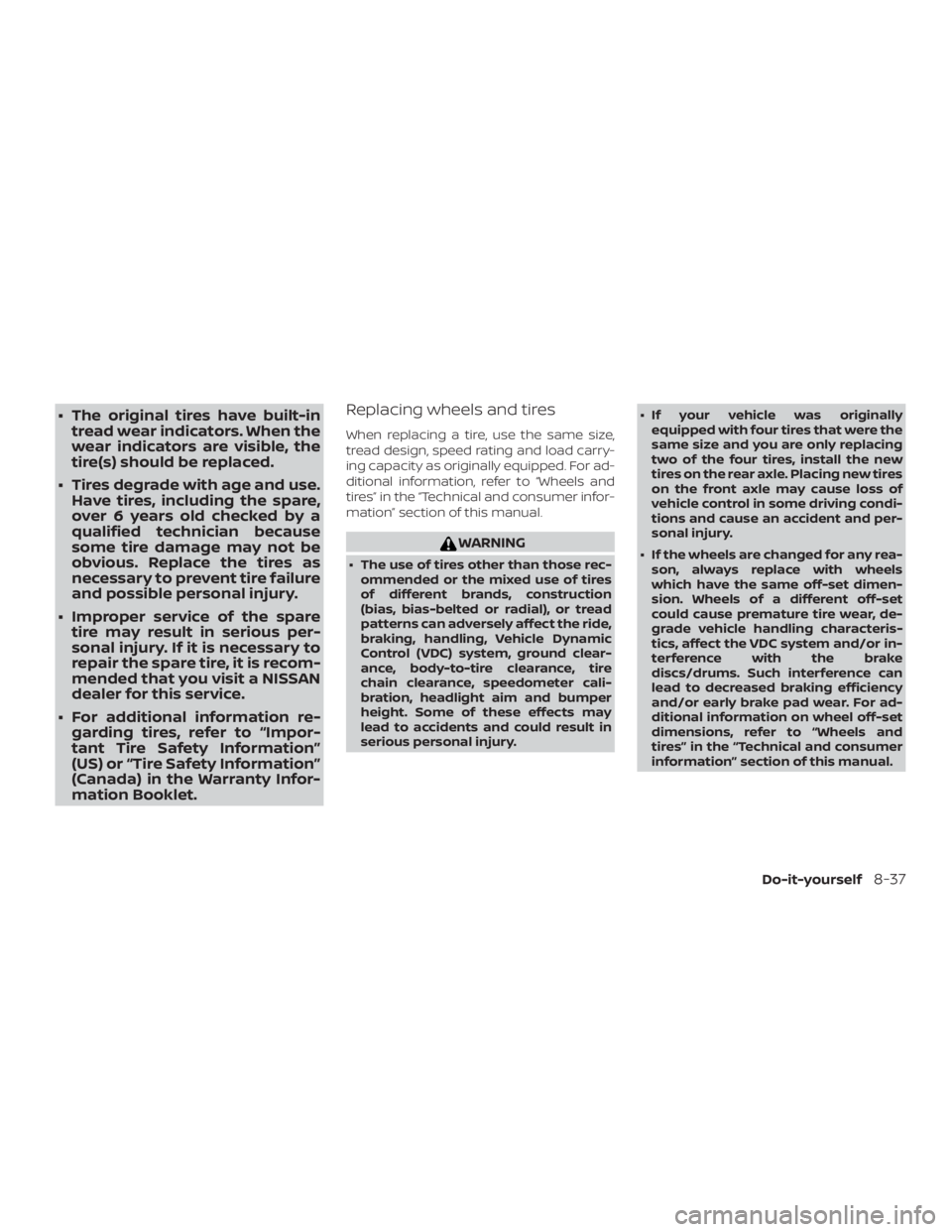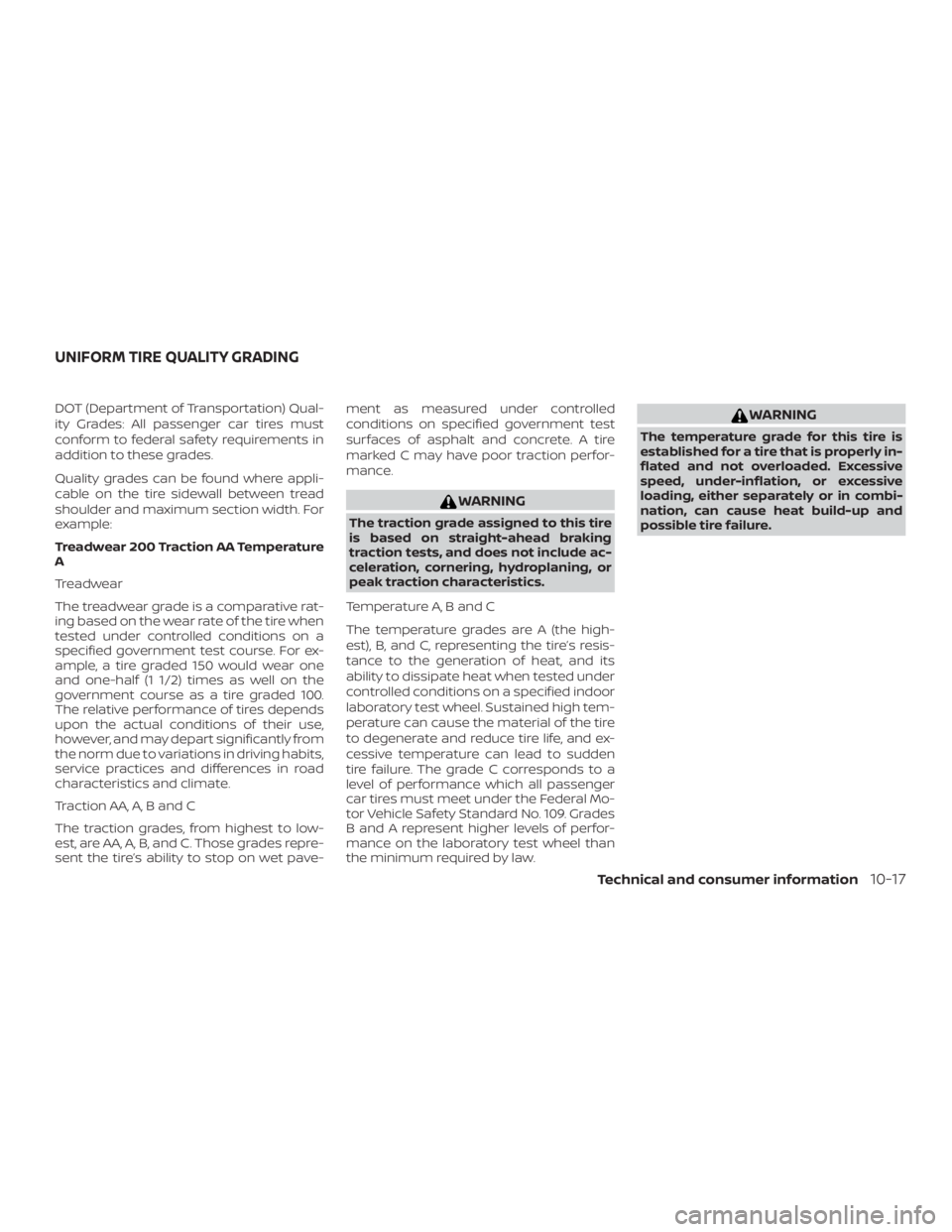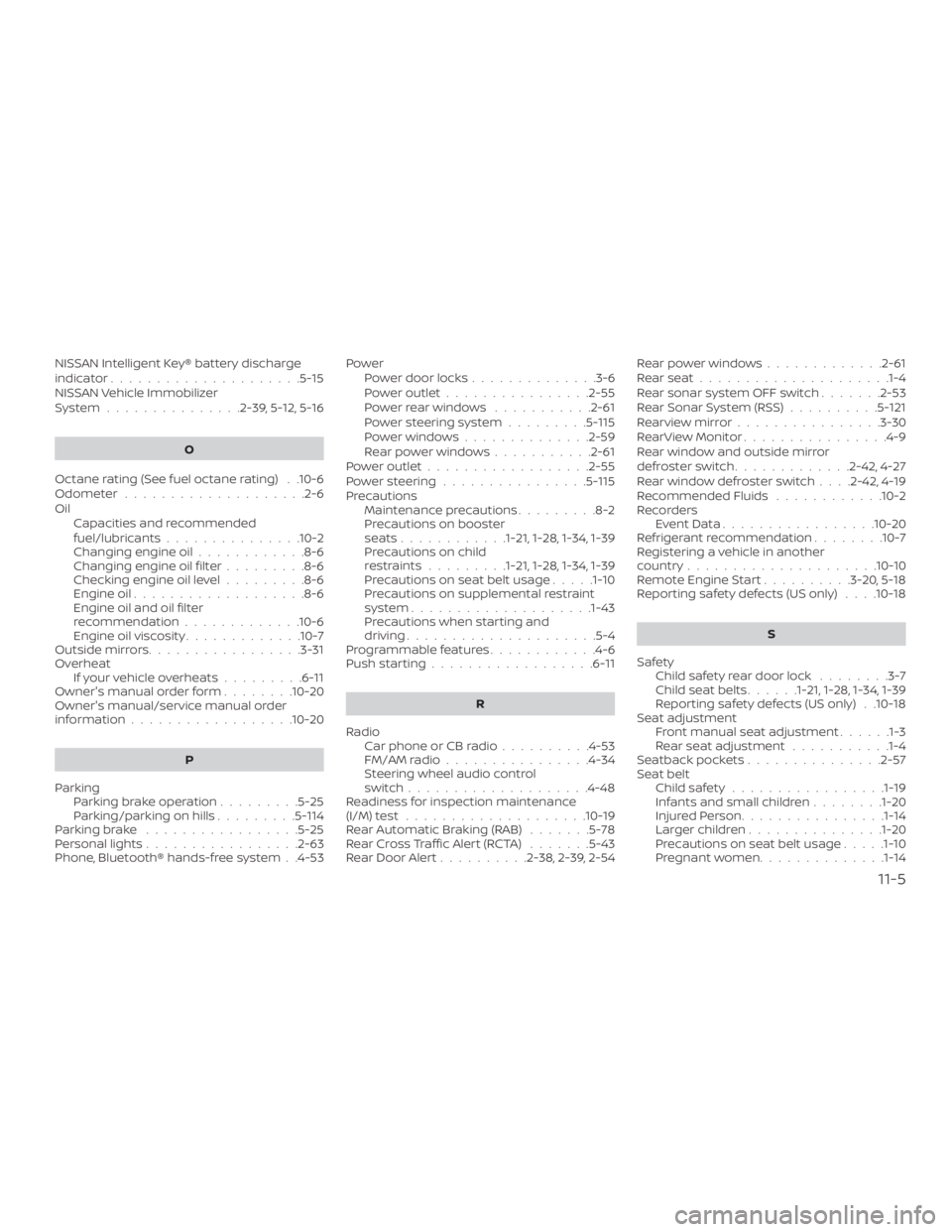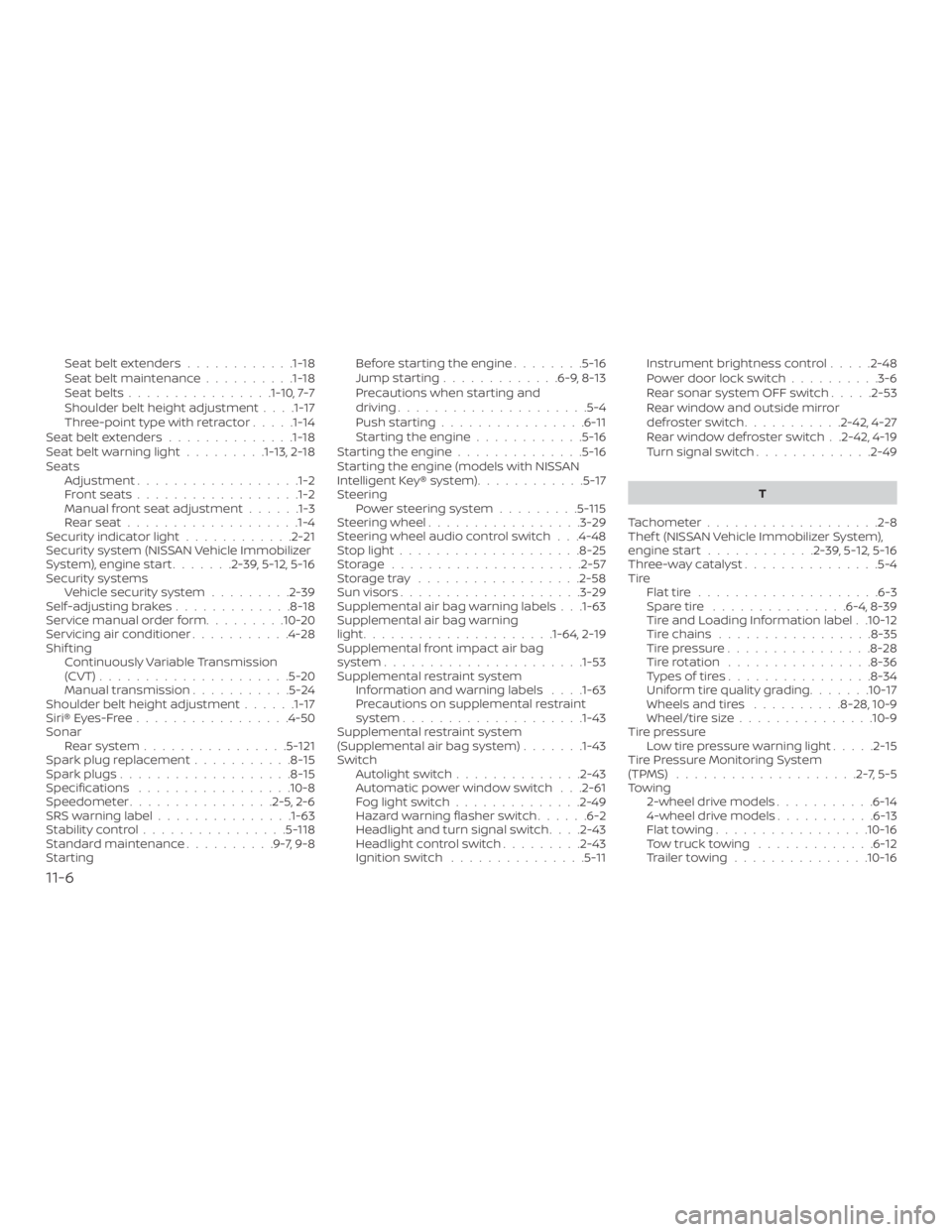2021 NISSAN VERSA SEDAN service
[x] Cancel search: servicePage 443 of 492

∙ The original tires have built-intread wear indicators. When the
wear indicators are visible, the
tire(s) should be replaced.
∙ Tires degrade with age and use. Have tires, including the spare,
over 6 years old checked by a
qualified technician because
some tire damage may not be
obvious. Replace the tires as
necessary to prevent tire failure
and possible personal injury.
∙ Improper service of the spare tire may result in serious per-
sonal injury. If it is necessary to
repair the spare tire, it is recom-
mended that you visit a NISSAN
dealer for this service.
∙ For additional information re- garding tires, refer to “Impor-
tant Tire Safety Information”
(US) or “Tire Safety Information”
(Canada) in the Warranty Infor-
mation Booklet.Replacing wheels and tires
When replacing a tire, use the same size,
tread design, speed rating and load carry-
ing capacity as originally equipped. For ad-
ditional information, refer to “Wheels and
tires” in the “Technical and consumer infor-
mation” section of this manual.
Page 444 of 492

∙ When replacing a wheel without theTPMS such as the spare tire, the TPMS
will not function and the low tire pres-
sure warning light will flash for ap-
proximately 1 minute. The light will re-
main on af ter 1 minute. Have your
tires replaced and/or TPMS system
reset as soon as possible. It is recom-
mended that you visit a NISSAN dealer
for this service.
∙ Replacing tires with those not origi- nally specified by NISSAN could affect
the proper operation of the TPMS.
∙ The TPMS sensor may be damaged if it is not handled correctly. Be careful
when handling the TPMS sensor.
∙ When replacing the TPMS sensor, the ID registration may be required. It is
recommended that you visit a NISSAN
dealer for ID registration.
∙ Do not use a valve stem cap that is not specified by NISSAN. The valve stem
cap may become stuck.
∙ Be sure that the valve stem caps are correctly fitted. Otherwise the valve
may be clogged up with dirt and
cause a malfunction or loss of
pressure. ∙ Do not install a damaged or deformed
wheel or tire even if it has been re-
paired. Such wheels or tires could
have structural damage and could fail
without warning.
∙ The use of retread tires is not recommended.
∙ For additional information regarding tires, refer to “Important Tire Safety
Information” (US) or “Tire Safety Infor-
mation” (Canada) in the Warranty In-
formation Booklet.
If excessive tire wear is found, it is recom-
mended that all four tires be replaced with
tires of the same size, brand, construction
and tread pattern. The tire pressure and
wheel alignment should also be checked
and corrected as necessary. It is recom-
mended that you visit a NISSAN dealer for
this service.
Wheel balance
Unbalanced wheels may affect vehicle
handling and tire life. Even with regular use,
wheels can get out of balance. Therefore,
they should be balanced as required. Wheel balance service should be per-
formed with the wheels off the vehicle.
Spin balancing the wheels on the vehicle
could lead to mechanical damage.
∙ For additional information regarding
tires, refer to “Important Tire Safety
Information” (US) or “Tire Safety In-
formation” (Canada) in the Warranty
Information Booklet.
Care of wheels
∙ Wash the wheels when washing the ve-
hicle to maintain their appearance.
∙ Clean the inner side of the wheels when the wheel is changed or the underside
of the vehicle is washed.
∙ Do not use abrasive cleaners when washing the wheels.
∙ Inspect wheel rims regularly for dents or corrosion. Such damage may cause
loss of pressure or poor seal at the tire
bead.
∙ NISSAN recommends waxing the road wheels to protect against road salt in
areas where it is used during winter.
8-38Do-it-yourself
Page 477 of 492

DOT (Department of Transportation) Qual-
ity Grades: All passenger car tires must
conform to federal safety requirements in
addition to these grades.
Quality grades can be found where appli-
cable on the tire sidewall between tread
shoulder and maximum section width. For
example:
Treadwear 200 Traction AA Temperature
A
Treadwear
The treadwear grade is a comparative rat-
ing based on the wear rate of the tire when
tested under controlled conditions on a
specified government test course. For ex-
ample, a tire graded 150 would wear one
and one-half (1 1/2) times as well on the
government course as a tire graded 100.
The relative performance of tires depends
upon the actual conditions of their use,
however, and may depart significantly from
the norm due to variations in driving habits,
service practices and differences in road
characteristics and climate.
Traction AA, A, B and C
The traction grades, from highest to low-
est, are AA, A, B, and C. Those grades repre-
sent the tire’s ability to stop on wet pave-ment as measured under controlled
conditions on specified government test
surfaces of asphalt and concrete. A tire
marked C may have poor traction perfor-
mance.
Page 485 of 492

NISSAN Intelligent Key® battery discharge
indicator.....................5-15
NISSAN Vehicle Immobilizer
System...............2-39,5-12,5-16O
Octane rating (See fuel octane rating) . .10-6
Odometer ....................2-6
Oil Capacities and recommended
fuel/lubricants...............10-2
Changing engine oil ............8-6
Changing engine oil filter .........8-6
Checking engine oil level .........8-6
Engine oil ...................8-6
Engine oil and oil filter
recommendation .............10-6
Engine oil viscosity .............10-7
Outsidemirrors.................3-31
Overheat Ifyourvehicleoverheats.........6-11
Owner's manual order form ........10-20
Owner's manual/service manual order
information..................10-20
P
Parking Parking brake operation .........5-25
Parking/parkingonhills.........5 -114
Parkingbrake .................5-25
Personal lights .................2-63
Phone, Bluetooth® hands-free system . .4-53 Power
Power door locks ..............3-6
Poweroutlet................2-55
Powerrearwindows ...........2-61
Power steering system .........5-115
Powerwindows..............2-59
Rearpowerwindows...........2-61
Poweroutlet..................2-55
Powersteering................5 -115
Precautions Maintenance precautions .........8-2
Precautions on booster
seats............1-21, 1-28, 1-34, 1-39
Precautions on child
restraints.........1-21, 1-28, 1-34, 1-39
Precautions on seat belt usage .....1-10
Precautions on supplemental restraint
system ....................1-43
Precautions when starting and
driving.....................5-4
Programmable features ............4-6
Push starting ..................6-11
R
Radio Car phone or CB radio ..........4-53
FM/AMradio................4-34
Steering wheel audio control
switch....................4-48
Readiness for inspection maintenance
(I/M) test ....................10-19
Rear Automatic Braking (RAB) .......5-78
RearCrossTrafficAlert(RCTA) .......5-43
Rear Door Alert ..........2-38,2-39,2-54 Rearpowerwindows.............2-61
Rearseat.....................1-4
Rear sonar system OFF switch
.......2-53
Rear Sonar System (RSS) ..........5-121
Rearviewmirror................3-30
RearViewMonitor................4-9
Rear window and outside mirror
defrosterswitch.............2-42,4-27
Rearwindowdefrosterswitch....2-42,4-19
Recommended Fluids ............10-2
Recorders EventData.................10-20
Refrigerant recommendation ........10-7
Registering a vehicle in another
country .....................10-10
Remote Engine Start ..........3-20,5-18
Reporting safety defects (US only) . . . .10-18
S
Safety Child safety rear door lock ........3-7
Childseatbelts......1-21, 1-28, 1-34, 1-39
Reporting safety defects (US only) . .10-18
Seat adjustment Front manual seat adjustment ......1-3
R e
ar seat adjustment ...........1-4
Seatback pockets ...............2-57
Seat belt Childsafety.................1-19
Infants and small children ........1-20
InjuredPerson............... .1-14
Largerchildren.............. .1-20
Precautionsonseatbeltusage.....1-10
Pregnant women ..............1-14
11-5
Page 486 of 492

Seat belt extenders............1-18
Seat belt maintenance ..........1-18
Seatbelts................1-10, 7-7
Shoulder belt height adjustment . . . .1-17
Three-pointtypewithretractor.....1-14
Seat belt extenders ..............1-18
Seatbeltwarninglight.........1-13, 2-18
Seats Adjustment ..................1-2
Frontseats..................1-2
Manual front seat adjustment ......1-3
Rearseat...................1-4
Security indicator light ............2-21
Security system (NISSAN Vehicle Immobilizer
System), engine start .......2-39,5-12,5-16
Security systems Vehicle security system .........2-39
Self-adjustingbrakes.............8-18
Service manual order form .........10-20
Servicing air conditioner ...........4-28
Shif ting Continuously Variable Transmission
(CVT) .....................5-20
Manual transmission ...........5-24
Shoulder belt height adjustment ......1-17
Siri® Eyes-Free .................4-50
Sonar Rear system ................5-121
Spark plug replacement ...........8-15
Spark plugs ...................8-15
Specifications .................10-8
Speedometer ................2-5,2-6
SRS warning label ...............1-63
Stability control ................5 -118
Standard maintenance ..........9-7,9-8
Starting Before starting the engine
........5-16
Jumpstarting.............6-9,8-13
Precautions when starting and
driving.....................5-4
Push starting ................6-11
Starting the engine ............5-16
Starting the engine ..............5-16
Starting the engine (models with NISSAN
Intelligent Key® system) ............5-17
Steering Powersteeringsystem.........5 -115
Steering wheel .................3-29
Steering wheel audio control switch . . .4-48
Stoplight....................8-25
Storage .....................2-57
Storagetray ..................2-58
Sunvisors....................3-29
Supplemental air bag warning labels . . .1-63
Supplemental air bag warning
light.....................1-64, 2-19
Supplemental front impact air bag
system ..................... .1-53
Supplemental restraint system Information and warning labels . . . .1-63
Precautions on supplemental restraint
system ....................1-43
Supplemental restraint system
(Supplemental air bag system) .......1-43
Switch Autolightswitch..............2-43
Automatic power window switch . . .2-61
Fo
glightswitch..............2-49
Hazard warning flasher switch ......6-2
Headlight and turn signal switch ....2-43
Headlightcontrolswitch.........2-43
Ignition switch ...............5-11 Instrument brightness control
.....2-48
Power door lock switch ..........3-6
Rear sonar system OFF switch .....2-53
Rear window and outside mirror
defrosterswitch...........2-42,4-27
Rear window defroster switch . .2-42, 4-19
Turn signal switch .............2-49
T
Tachometer ...................2-8
Thef t (NISSAN Vehicle Immobilizer System),
engine start ............2-39,5-12,5-16
Three-waycatalyst...............5-4
Tire Flattire....................6-3
Spare tire ...............6-4,8-39
Tire and Loading Information label . .10-12
Tire chains .................8-35
Tire pressure ................8-28
Tirerotation ................8-36
Types of tires ................8-34
Uniform tire quality grading .......10-17
Wheels and tires ..........8-28,10-9
Wheel/tire size ...............10-9
Tire pressure Low tire pressure warning light .....2-15
Tire Pressure Monitoring System
(TPMS) ....................2-7, 5-5
Towing 2-wheel drive models ...........6-14
4-wheel drive models ...........6-13
Flattowing.................10-16
Towtrucktowing .............6-12
Trailertowing...............10-16
11-6